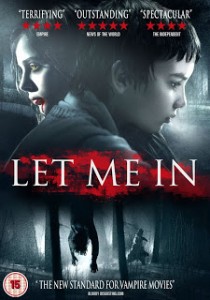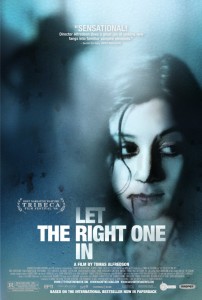In honor of Halloween, coming in a little more than two weeks, I decided to write a post concerning horror movies. Specifically, I will be discussing two films: “Let the Right One In” and “Let Me In.” The first is a Swedish-language horror film from 2008, directed by Tomas Alfredson; while the second is the American remake that came a couple years later, directed by Matt Reeves. Of the two, it is “Let the Right One In” that will most likely be remembered in coming years. Yet, in a sea of mediocre remakes, “Let Me In” rises above most of them, and is at least comparable to the original.
Let the Right One In
“Let the Right One In” (called Låt den rätte komma in Swedish) is set in Blackeberg, a suburb of Stockholm. Our main focus is on that of Oskar (Kåre Hedebrant); a depressed, reserved 12-year-old boy with almost no friends. Under the constant threat of bullies at school, Oskar is also the victim of neglectful parents, who live separately. While stabbing a tree in his courtyard one evening, pretending that he is actually hurting his bullies at school, he comes face-to-face with Eli (Lena Leandersson). The two almost instantly connect, despite Eli’s initial warning that “we can’t be friends.” But they feel a strong pull towards one another, and after some time find that they belong together. Unfortunately for Oskar, though, Eli is actually a vampire.
With a slow, tranquil pace, “Let the Right One In” flows like a gentle stream from one scene to the next, at times unfolding into savage violence, yet never quite losing its tender flow. Each fragment of the film expresses a development in the growing emotional connection of our two “young” lovers: from the frightened, curious face of Oskar as he stares up at his mysterious friend perched on the jungle gym in their snowy courtyard, to the later look of unyielding acceptance as he finally discovers, and then witnesses first-hand, her true self. “Are you a vampire?” he asks her. “I live off blood, yes” is her simple response.
To Oskar, Eli seems to represent all that he wishes he could be. While he fantasizes about, and wishes he could kill the boys that bully him, he is never able to work up the courage. Eli, on the other hand, actually has to kill people in order to survive. So are they really that different? Our two main actors express this ideal with delicacy, and with expertise beyond their years. Never once does it feel as if they are struggling to perform, which is especially impressive considering the heavy weight of this film.
Powerful and haunting, the Swedish version of this vampire story is a modern masterpiece, laden with transcendently beautiful images. Whether you remember the nasty growling and sucking noises as Eli drinks the flowing blood from a person’s neck, or the much-nicer picture of the two children crouched on either side of the connecting walls of their bedrooms, tapping out messages in morse code; either way, the experience is bound to stay with you. And now, onto the American version.
Let Me In
 In the American version of this film, “Let Me In” is about a boy named Owen (Kodi Smit-McPhee), who lives in Los Alamos, New Mexico. Like Oskar, he is also the victim of bullies, and is emotionally distant due to a broken family. One evening, he meets Abby (Chloë Grace Moretz), and the two strike up a surprisingly similar conversation as the first from “Let the Right One In.” In truth, other than setting, character names, and a few scenes that have been altered slightly, “Let Me In” is almost identical to “Let the Right One In.” Yet, while its story is much the same, the manner in which it is presented differs greatly.
In the American version of this film, “Let Me In” is about a boy named Owen (Kodi Smit-McPhee), who lives in Los Alamos, New Mexico. Like Oskar, he is also the victim of bullies, and is emotionally distant due to a broken family. One evening, he meets Abby (Chloë Grace Moretz), and the two strike up a surprisingly similar conversation as the first from “Let the Right One In.” In truth, other than setting, character names, and a few scenes that have been altered slightly, “Let Me In” is almost identical to “Let the Right One In.” Yet, while its story is much the same, the manner in which it is presented differs greatly.
“Let Me In” was made with one clear purpose: to make the film more accessible to American audiences, who seem to have an issue with reading subtitles, or with the unconventionality of foreign films in general. It is this component that manifests itself throughout the length of the film. An example is the first scene, which chronologically fits towards the middle of the events. A deformed man is in the hospital, and a detective is asking him questions, as he suspects that the man was involved in some kind of satanic behavior. Who is the man in the bed, we wonder, and why is he being interrogated by the detective?
What this scene unintentionally does is transform an eerie horror tale into something more related to a supernatural detective mystery, such as would be seen in an episode of “The X-Files” or “Fringe.” So, when the romantic undertones finally develop, some of the magic has already dissipated. In the original, there is almost no indication of the police searching for a killer, and this leaves the primary focus of the film on our two young characters. And, as a result, there is more time for their emotional development.
In a few select scenes, this version also dwells too long on the shock and gore factor that has become so common in recent American films. An example is the audience’s first viewing of Abby’s killing, when the camera focuses on her yellow glowing eyes and pale ghostly face. In the original, only vague shadows and shapes are seen when Eli attacks someone, with the only proof of the kill being the blood dripping down her chin afterwards. This becomes even more unsettling, as we are now forced to imagine this sweet-faced girl as a brutal killer. It is often what we don’t see that makes things even more frightening.
Yet, as mentioned, “Let Me In” does also succeed in many ways. The original story, from start to finish, remains intact, and ends in the same place. The two young actors imbibe just as believable performances as the original, even if the understated tone of their relationship is not as deeply moving. A special emphasis must be made for Chloë Grace Moretz, whose creepy performance here as the vampire Abby most likely prepared her for another supernatural role, that of the title character in “Carrie” (premiering October 18). There are also a few slight details that may have even been an improvement, such as the appearance of the play “Romeo and Juliet,” which reminds us that Owen and Abby are star-crossed lovers of their own.
For anybody into vampires, “Let Me In” is one of the better American takes on the tale, one that far surpasses in quality another popular saga that has, unfortunately, surpassed it in profit. Matt Reeves, the director, who also did “Cloverfield,” knows how to scare American audiences. And “Let Me In” is sure to scare. I just wish it was more subtle about it.

